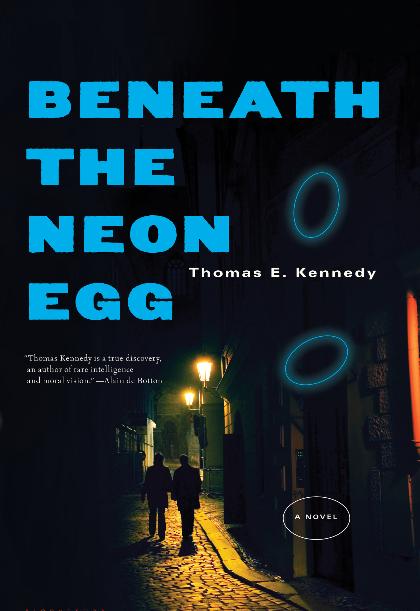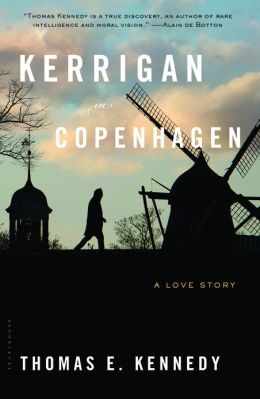You have /5 articles left.
Sign up for a free account or log in.
Beneath The Neon Egg. Bloomsbury, August 2014.
Kerrigan in Copenhagen: A Love Story. Bloomsbury, August 2014.
In the Company of Angels: A Novel. Bloomsbury, 2011.
Falling Sideways: A Novel. Bloomsbury, 2011.
***
REVIEW BY SEAN SINGER
 Thomas E. Kennedy’s Copenhagen Quartet -- four jazz-inflected novels set in Copenhagen -- is completed now with his fourth novel, Beneath the Neon Egg. Each novel is set in a different season and in a different style. The fourth, a love story set in winter amid a John Coltrane soundtrack and structure, begins in lust and ends in a complacent hopefulness.
Thomas E. Kennedy’s Copenhagen Quartet -- four jazz-inflected novels set in Copenhagen -- is completed now with his fourth novel, Beneath the Neon Egg. Each novel is set in a different season and in a different style. The fourth, a love story set in winter amid a John Coltrane soundtrack and structure, begins in lust and ends in a complacent hopefulness.
Behind all the longing, tinged with violence and degradation, the hero --Patrick Bluett, known as Bluett, 43, American ex-pat in Denmark, jazz fan, and in love with a Danish woman called Liselotte—drinks, gets assaulted, falls in love while denying he’s looking for love, makes amends with his college-age children, and lives the blues. He’s all gesture and gaze. He’s nobody and an omen. He’s a thought and a vibration. Meanwhile, his counterpart, Sam Finglas, is in love with a Russian prostitute, Svetlana. Crime, deceit, passion, and tragedy follow Sam and Bluett, like shadows, or the edge of a knife.
The book is set in winter and is set then, perhaps, because in the freeze everything stops: snow makes time move more slowly. When François Villon wrote “Mais où sont les neiges d'antan!/ where are the snows of yesteryear!” he could also have been talking about this novel. While pushing through the web of memory, Bluett vacillates between feeling sorry for himself while pursuing Liselotte, whose beauty haunts the very memories he purports to try to navigate and preserve. Flaubert said: “If you want to describe courage, do not become a soldier; a lover, do not fall in love; a drunkard, do not drink wine.” Beneath the Neon Egg must be a brilliant refutation of that idea.
Writing sex is treacherous ground for any writer; in its balance of realism and fantasy, the writer must imbue her words -- inert objects -- with a tone that can make it all accurate while being surprising. Sometimes Kennedy taps into something, a real experience among men: an unfocused longing:
All my life, he thinks, decade after decade, I ask myself is it really true, am I deluded, can this be a fact? But decade after decade, my eye, my heart, my body tell me the most beautiful thing in this world is to see a woman walk, to see a woman, to look in a woman’s eyes, kiss a woman’s mouth. What I am to do with her and what it is all about I do not know. I used to think it was sex, to fuck, but it is not really that at all. It is to touch, share a moment. He remembers moments with his wife over all their years together and feels unreal to think they are apart, that their life together failed. But it did. And that’s that.
Notice the italicized thoughts merge into the third-person omniscient narrator’s. Is Kennedy Bluett? Is Bluett Kennedy? What is the moment? At other times, the sex in the book almost makes the reader laugh, an unintended consequence: “For further inspiration, they visit the Museum Erotica on Købmagergade, where, as they stand looking at a photograph of the longest recorded human penis in history, thirty-two centimeters slack, she whispers in his ear, ‘I want my mouth full of your prick.’ He whispers, ‘And I want to eat your cunt.’” Do people in novels, or in life, talk this way? They do here, but Bluett’s tone is tinged with self-deprecation and panic.
A recurring ribbon in Beneath the Neon Egg is the late Miles Davis concept album, Aura. It was designed by the Danish musician Palle Mikkelborg. It’s a hybrid of jazz, pop, classical, and electronic music: all texture, color, and orchestral noodling. The novel is a little like that: it’s a love letter to jazz as form and subject, yet it circumvents race. It’s a love letter to love, but love with a prostitute who cannot commit to the protagonist, even though he swears against a “relationship”; yet she demands one and he seems to be drawn to her as a real source of empathy. It’s a love letter to Copenhagen, yet told from the perspective of an American immigrant, and only set in parts of Copenhagen far off the guidebooks’ suggestions. Many moments of “…Bluett raises his glass in response and hearts the chest-deep notes of Miles saving him from loneliness, from despair.”
In a particularly muscular example of form meeting content, Bluett remembers what divorce does to passion, stability, memory, and the important of friends, if there are any friendships to maintain. In a long, breathless sentence, hinged together with commas, Kennedy shows his stuff:
She has been divorced two times, and they talk about the experience— how it is not fun, how you always wonder if you really did enough, tried enough, and of course no one ever does, but it also takes give from the other side, but sometimes you wonder if maybe the problem is that you gave too much, that you should have put your foot down instead of trying to understand, and who ever knows really, maybe in fact marriage is an outmoded institution, maybe we are evolving toward some other form of society, but sometimes it is hard to see any way around the fact that the basic unit would always be one man and one woman with children, but of course it is entirely possible to love many persons at one and the same time, and who is to say what is right, and in truth sometimes there comes a time when you know deep down in your heart that a marriage is over, done, dead, harmful, nothing left but two people full of contempt for one another and what is left to do then but get out and try to do it as gently and understandingly as possible even though probably no divorce is reasonable or civilized despite your best intentions because the emotions involved are not civilized emotions, there is always rage and sorrow and deep pain and there is a time when more than anything you need your friends, it is not fun, maybe at first you feel good to be alone but after a while, well, who knows?
Kennedy shows how regret and longing are somehow tied in the same yoke. Bluett’s memories merge, spilling over each other, until a rhetorical question approaches and lands.
In Kennedy’s other novels social conventions thwart the protagonist, as in Falling Sideways, which is set in autumn when a CEO downsizes a company and a man’s family, lovers, and spouses get salvaged in the fallout. Taking cues from the spirit of Pier Paolo Pasolini’s Teorema, Falling Sideways shows a miniature of a society wrecked by the visitation of doom, even as they try to interrogate their own motions and conversations.

In the thread of the writer’s eye the city itself, Copenhagen, becomes the real muse. Sometimes Kennedy’s work is an act of protest and sometimes it’s an act of self-portraiture. Individualism and going your own way may be an American quality, but it’s anathema to a certain Danish sensibility. Bluett tries to balance his own wandering self-immolation and self-pity with a new vision: through his mysterious dance with his Russian muse, and through his urgent dialogue of possibility in the form of Coltrane and Miles, Bluett changes. His arc is one of bravery, a kind of acting via not pursuing a dream, but through wisdom of knowing oneself: he will be what he be. When Bluett tries to avenge his friend—driven to suicide—he enters Copenhagen’s underground only to find himself deeper in the blues than before.
Especially in his attempts to explore a kind of 40s-50s male who has lived among books and records, and drinks his way through problems, particularly those of involving his muse, Kennedy shows sensitivity and grace. The Quartet is for all the mariners plunging to unknown destinations within themselves.
***
Sean Singer’s first book, Discography, won the Yale Series of Younger Poets Prize, selected by W.S. Merwin, and the Norma Farber First Book Award from the Poetry Society of America. His second book, Honey & Smoke, is forthcoming from Eyewear Publishing in 2015. His work has recently appeared in Pleiades, Iowa Review, New England Review, and Salmagundi. He has a Ph.D. in American Studies from Rutgers-Newark and is the recipient of a National Endowment for the Arts fellowship. He lives in New York City.

